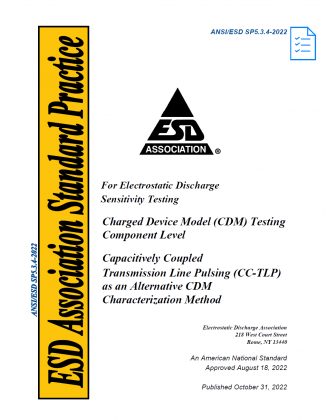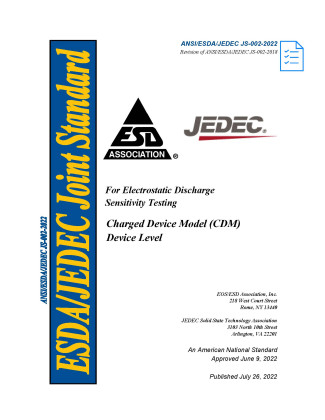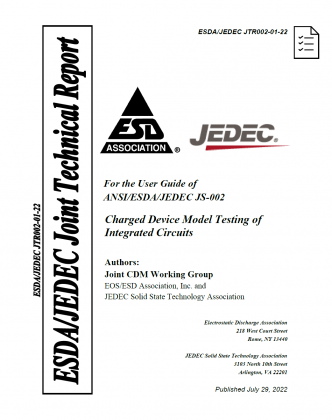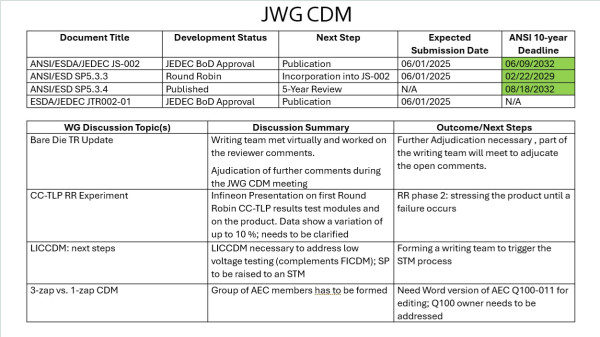JWG – Charged Device Model (CDM) Device Testing
- Status:
- Active
- Working Group Chair:
- Co-Chairs: Alan Righter, Analog Devices, Inc.; Heinrich Wolf, Fraunhofer EMFT
-
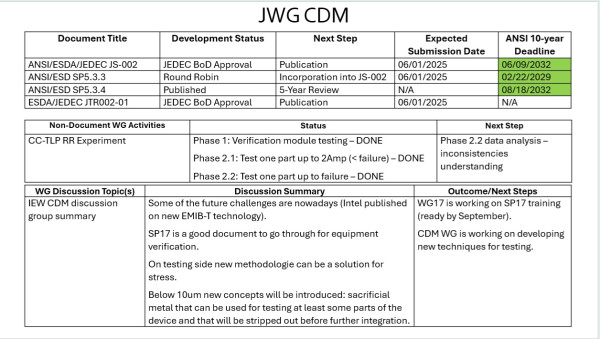
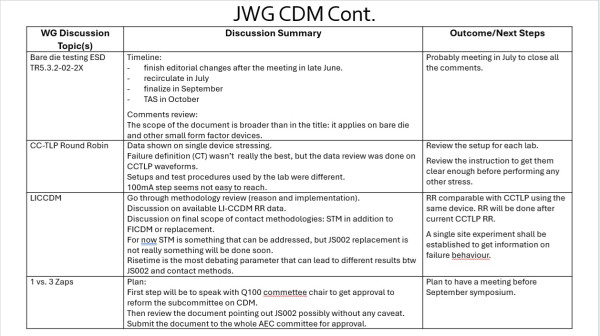
-
-
Summary of discussions/activities/document reviews during the most recent WG meeting.
- Bare Die TR Update – TR draft complete and in review process by CDM JWG
- Three CDM-related presentations from 2024 ESD Symposium presentations
- CC-TLP Round Robin Experiment: updated Infineon plan presented – JWG discussion, plan for further meetings to fully define experiment and statistical needs
- AEC 3-zap vs. 1-zap CDM. HBM alignment to ESDA/JEDEC standards – plan to work with AEC committee and leadership to align AEC standards in CDM and HBM more completely to ESDA/JEDEC CDM / HBM standards
-
Bare Die TR is nearing completion and scheduled for JWG review in the summer before the September TAS meeting. There was a discussion on the CC-TLP Round Robin Experiment, with plans for further meetings to define experiment details and statistical requirements. Updates on the 3-zap vs. 1-zap CDM debate, including discussion on the next steps for AEC involvement in potentially amending AEC Q100-011 to allow a single zap.
-
The JWG adjudicated the remaining TAS comments for JTR002 CDM User Guide Revision, reviewed the next steps for CC-TLP with a presentation and round robin data gathering discussion, and reviewed the bare die TR draft status.
-
The WG reviewed the changes made by the writing team on the limited ballot of ANSI/ESDA/JEDEC JS-002-2022 and ESDA/JEDEC JTR002 documents, which are related to the removal of 1GHz oscilloscope information in both documents. There was also a review of the status of the TR draft on bare die CDM testing. There were a few presentations given, prompting discussions on further topics related to:
- Time-Dependent Conductance in CDM and Implications for D2D Manufacturing
- Voltage to Current Correlation for CDM Testing (CDM test of small packages)
- ESD Risk Assessment for Devices on Printed Circuits Boards
- further data on 1-zap vs. 3-zap CDM data/justification
-
The WG reviewed the first drafts of the limited ballot changes for ANSI/ESDA/JEDEC JS-002-2022 and ESDA/JEDEC JTR002, primarily removing 1 GHz oscilloscope information from both. The WG reviewed the status of the new bare die CDM technical report. The group also reviewed/discussed:
- zap vs. 3 zap CDM data
- Justification to incorporate LICCDM into JS-002
- Round Robin scope of work
-
A novel methodology to measure peak current in an IC pick and place process was presented. The draft slides for making a case for harmonization of the automotive sector to accept a Single Zap per pin per polarity CDM (per JS-002) rather than requiring three zaps per pin per polarity CDM were reviewed. The WG members agreed to remove the 1-GHz Bandwidth oscilloscope description and procedure from JS-002 by a limited ballot.
-
An update was given on the new bare die TR document being written. A preview of a paper from this year’s Symposium – “Limitation of CDM Testing for Small Devices”, was presented. Some questions were brought up by members on the limitations. An update was given on the LICCDM round-robin FA results and the next steps required to move this method forward. There was also a discussion on whether this method would be a stand-alone test or be added to ANSI/ESDA/JEDEC JS-002 as an alternative method for low voltage or small pin pitch device testing. A small team was formed to plan how the LICCDM test method could integrate into a revision of ANSI/ESDA/JEDEC JS-002. Status updates were provided on ANSI/ESDA/JEDEC JS-002, ESDA/JEDEC JTR002, and ANSI/ESD SP5.3.1.
-
An update was given on the LICCDM round robin FA results and the next steps required to move this method forward. There was also a discussion on whether this method would be a standard alone test or be added to the JS-002 standard as an alternative method for low voltage or small pin pitch device testing. A presentation was given on the results of product testing using 3-zap vs. 1-zap for field induced CDM testing. Another presentation was given on 1-ohm CDM resistor frequency response. There were also discussions on including this information in an annex in ANSI/ESDA/JEDEC JS-002.
-
The WG adjudicated Industry Review comments on WIP5.3.4 “CC-TLP”. All proposed changes were accepted, and the step is to finalize edits and send to headquarters for a final check and publication.
Low Impedance Contact CDM (LI-CCDM) Round Robin (RR) data was presented. The RR test results across the multiple sites showed similar failure levels on the different device types. Failure analysis (damage signatures) are still being analyzed to determine whether they correlate between sites and with expected Field Induced CDM signatures.
A presentation was made on the “Analysis of (small) Coins – Findings and Consequences”. Data comparisons were made on experimental targets to better understand the effects targets can have on waveform repeatability and reproducibility.
-
The joint working group adjudicated industry review comments on the five year review revisions of ANSI/ESDA/JEDEC JS-002. The joint working group also adjudicated TAS comments on the new user guide technical report – ESD JTR002-01. A data update on the LICCDM round robin was given and methods for improving current measurement were discussed. STDCOM VBM comments for a new standard practice on CC-TLP (ESD WIP5.3.4) were adjudicated.
-
The joint working group adjudicated STDCOM recirculation vote comments on ESDA/JEDEC JS-002-2021. An update was provided on the status of the LICCDM round-robin testing. A presentation was given on the low voltage CDM discussion group summary from the 2021 International ESD Workshop (IEW).
-
The joint committee reviewed the status of the CDM testing round-robin. A presentation was given on the asymmetry of the 1-ohm disk resistor. The group adjudicated STDCOM VBM comments on ESDA/JEDEC JWIP-002.
-
Agenda:
- ESDA meeting policies
- Brief review of CDM activities / recent work in JWG – documents in process
- Continuing presentation on CDM JWG waveform analysis report
- Round robin data update
- JEITA / JS-002 team activity
- JEDEC January 21 meeting report
- Old / new business
